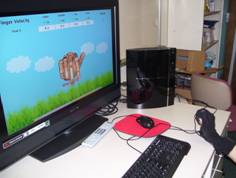PlayStation 3-based Tele-rehabilitation for Children with Hemiplegia
Project Overview
- What's the problem?
- Why Tele-rehabilitation?
- What we've done?
- Who was included?
- The exercises/games.
- What have we found?
- Related publications.
- Collaboration.
- Press Releases.
- Project Video - Subject progress over 10 months of therapy. (~10mb MPEG4)

What's the problem?
Why Tele-rehabilitation?
What we've done?
Who was included?
The exercises/games.
Sliders - Range-of-Motion
Butterfly / UFO - Finger Velocity
What have we found?
All 3 adolescents showed improved function of the plegic hand on occupational therapy testing, including increased ability to lift objects, and improved finger ROM based on remote measurements. The 2 adolescents who were most compliant showed improvements in radial bone mineral content and area in the plegic arm. For all 3 adolescents, fMRI during grip task contrasting the plegic and nonplegic hand showed expanded spatial extent of activation at posttreatment relative to baseline in brain motor circuitry (eg, primary motor cortex and cerebellum).
Use of remotely monitored virtual reality videogame telerehabilitation appears to produce improved hand function and forearm bone health (as measured by DXA and pQCT) in adolescents with chronic disability who practice regularly. Improved hand function appears to be reflected in functional brain changes.
Related publications.
-
M. R. Golomb, S. Warden, J. Yonkman, B. Shirley, E. Fess, B. Rabin, and G. Burdea, Maintained Hand Function and Forearm Bone Health 14 Months After an In-Home Virtual-Reality Videogame Hand Telerehabilitation Intervention in an Adolescent With Hemiplegic Cerebral Palsy, Journal of Child Neurology. 2011; 26(3):289-393. Full Text PDF
-
Huber, M, B. Rabin, C. Docan, G. Burdea, M. Abdelbaky, and M. Golomb, Feasibility of modified remotely-monitored in-home gaming technology for improving hand function in adolescents with cerebral palsy, IEEE Transactions on Information Technology in Biomedical Engineering, 14(2):526-534, March 2010. Full Text PDF
Golomb, M., Brenna McDonald, Stuart J. Warden, Janell Yonkman, Andrew Saykin, Bridget Shirley, Meghan Huber, Bryan Rabin, Moustafa AbdelBaky, Michelle Nwosu, Monica Barkat-Masih, Grigore Burdea, In-Home Virtual Reality Videogame Tele-rehabilitation in Children with Hemiplegic Cerebral Palsy, Archives of Physical Medicine and Rehabilitation, 91:1-8, January 2010. Full Text PDF
M. R. Golomb, M. Barkat-Masih, B. Rabin, M. Abdelbaky, M. Huber, G. Burdea, Eleven Months of Home Virtual Tele-rehabilitation - Lessons Learned, Proc. Virtual Rehabilitation 2009 International Conf, Haifa, Israel, pp. 23-28, 2009. Full Text PDF
Huber, M, B. Rabin, C. Docan, G. Burdea, M. Nwosu, M. Abdelbaky and M. Golomb, PlayStation 3-based Tele-rehabilitation for Children with Hemiplegia, Proceedings of Virtual Rehabilitation 2008, pp. 105-112, Vancouver, Canada, August 25-27, 2008. Full Text PDF
In collaboration with:
Golomb, Meredith R., M.D.
Supported by:
- National Institutes of Health (National Institute of Neurological
Disorders and Stroke grant no. K23 NS048024) - Clarian Values Fund (grant no.VFR-171)
- Center of Excellence in Neuroimaging
- Indiana Economic Development Corporation (grant no. 87884)
-
Press Releases:
Project Video

The finger range of motion game asked participants to start by making a fist (when extension was trained) or to first open their hand as much as possible (when flexion was trained). Subsequently, each of the four fingers was mapped to a bar of 'dirty' pixels which occluded a portion of a pleasant image. Images were randomized, to maintain interest and chosen from scenes familiar to the participants (corn, Indy 500 racetrack, Indianapolis landscape, favorite pets, etc.). The task was to 'clean up' the screen, uncovering the image in proportion to each finger contribution. This provided an easily understood knowledge of performance (KP). When the exercise trained the thumb the whole image was uncovered proportional to the amount of thumb movement. Additional KP was provided numerically by the graphical user interface (GUI) at the top portion of the screen. This GUI displayed numerically finger-specific range data, comparing current finger performance to target performance. The GUI also displayed the total exercise time for that game. A 'Window cleaning' sound was played to add realism and increase immersion into the game.


The 'butterfly game' asked the participant to first make a fist (if extension was trained) or open their hand as much as possible (if flexion was trained). Subsequently virtual butterflies appeared from the side of the screen and needed to be 'scared away' by moving the fingers or the thumb fast. As long as the participant achieved the set flexion/extension goals before the butterfly reached the hand avatar, it would fly away. Otherwise, the butterfly flew back to the hand and had to be scared away again. After a number of butterflies had been scared away, a mosquito attempted to sting the hand avatar. The participant had to move the fingers fast enough to scare the mosquito away, else the hand flashed red and a corresponding unpleasant sound was produced. The difficulty of the game was increased by making the butterflies or the mosquitoes fly faster, thus requiring faster finger reaction time. The GUI was similar to that of the previous game, and congratulatory text was displayed at exercise end.
A second version of the velocity training game used UFOs instead of butterflies. In the 'bonus' round, the UFO beamed a 'shrink ray' if the participant had not opened/closed the hand fast enough. The hand avatar then turned green and shrank. If however, the participant had moved the fingers fast, the UFO flew away and crashed (with a corresponding explosion sound). The participants preferred this version of the game, as the scene was more appealing to them.
Click here to see the press releases.
